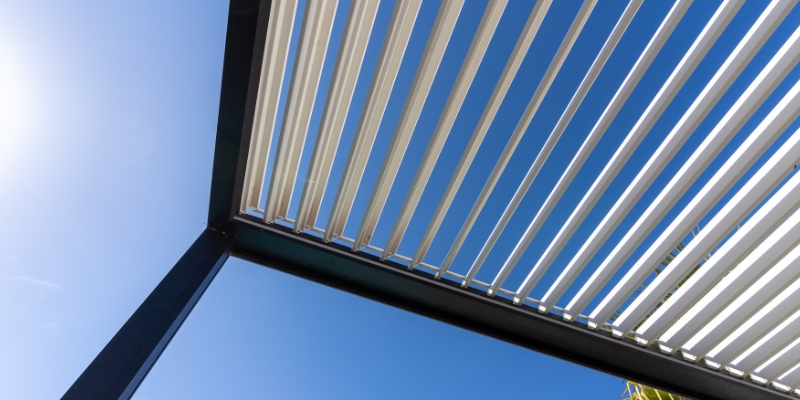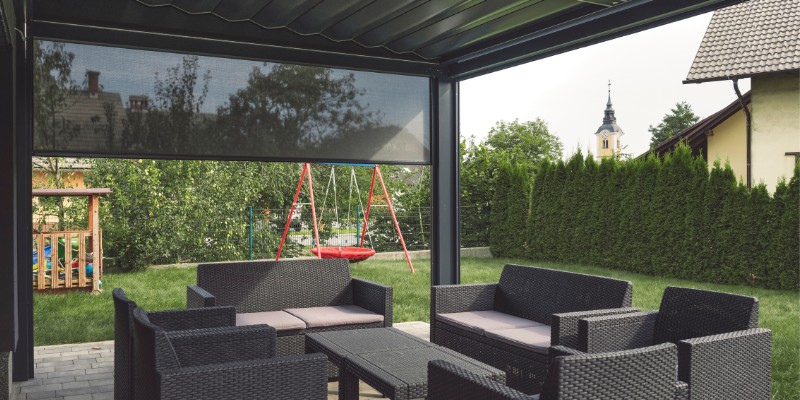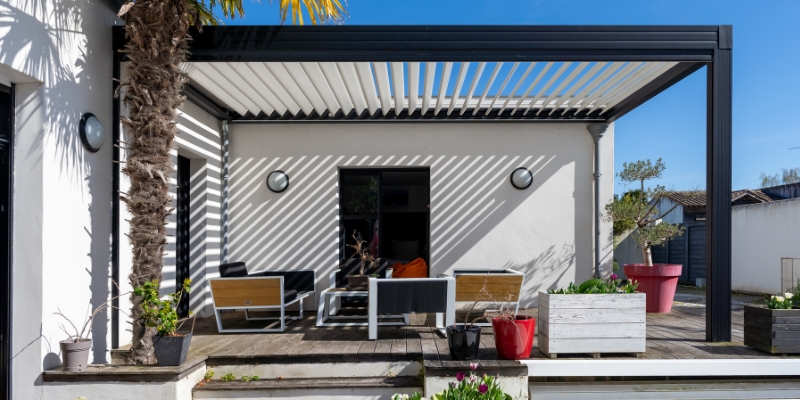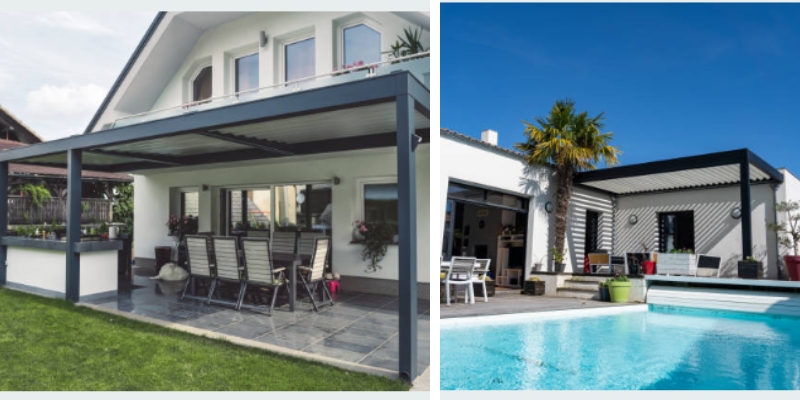
When it comes to enhancing outdoor spaces, aluminum pergolas have gained immense popularity due to their durability, versatility, and aesthetic appeal.
However, as homeowners and outdoor enthusiasts consider incorporating these structures into their gardens or patios, a common question often arises: Do aluminum pergolas get hot?
Understanding the heat retention properties of aluminum pergolas is crucial for creating a comfortable and enjoyable outdoor environment.
In this article, we will explore the science behind heat retention, examine the factors affecting heat absorption, and provide valuable insights on how to effectively manage heat in aluminum pergolas.
Is Aluminum Pergola Heat Resistant?
It is critical to grasp the physics of thermal conductivity in order to understand the behavior of aluminum pergolas with respect to heat.
Aluminum is a lightweight material well renowned for its excellent thermal conductivity, which essentially means that this lightweight material can quickly transport heat. However, the amount of heat absorbed by aluminum pergolas can be influenced by a variety of factors.
Factors Affecting Heat Absorption
The color and finish of the aluminum play a significant role in heat absorption. Dark-colored or black finishes tend to absorb more heat than lighter or reflective finishes. Therefore, the choice of pergola color can impact the temperature of the pergola structure and the surrounding area.
Sun exposure and shading also affect heat absorption. Direct sunlight can significantly increase the temperature of aluminum surfaces while various extra shading fabrics or elements such as trees, retractable canopies, or pergola covers can help minimize heat buildup.
Air circulation and ventilation within the aluminum pergola structure are additional factors to consider. Proper airflow and ventilation can help dissipate heat and maintain a more comfortable environment. Open-roof designs and adjustable louvers are effective ways to promote air circulation.
Aluminum Pergolas and Heat
Now, let’s address the question of whether aluminum pergolas get hot.
Despite aluminum’s high thermal conductivity, aluminum pergolas are designed to withstand and manage heat effectively. Aluminum possesses excellent heat resistance, which means it does not readily conduct heat to its surroundings.
This characteristic enables aluminum pergolas to remain cooler than expected, even when exposed to direct sunlight. While aluminum pergolas do absorb heat, their efficient heat dissipation properties prevent excessive heat buildup.
The open-roof design common in many aluminum pergolas allows hot air to rise and escape, reducing the overall temperature beneath the structure.
Additionally, the use of reflective finishes or lighter colors can further minimize heat absorption.
Additional Features for Aluminum Pergola Heat Management
To optimize heat management within aluminum pergolas, various design elements can be incorporated.
- The design and structure of the pergola itself can play a vital role in managing heat buildup. Open-roof structures allow hot air to escape, while partially-covered designs provide shade and reduce direct sunlight exposure.
- Integration of shade elements is another effective way to provide shade and manage heat. Retractable canopies, pergola covers, or adjustable louvers can be added to provide shade when needed, reducing the impact of direct sunlight and minimizing heat absorption.
- Utilizing natural ventilation is another crucial consideration. Placing the aluminum pergola in a well-ventilated area and ensuring proper airflow can help dissipate heat naturally. Surrounding greenery and landscaping elements can contribute to a cooler environment as well.
Insulation and Cooling Options
For those seeking additional heat management options, insulation and cooling features can be incorporated into aluminum pergolas.
Insulated roof panels can minimize heat transfer from the outside, providing a cooler space underneath. These panels typically consist of multiple layers with insulating pergola materials in between.
Incorporating ceiling fans or misting systems can further enhance comfort by creating a refreshing breeze or cooling mist during hot summer days. These features facilitate airflow and help regulate the temperature within the pergola, ensuring a pleasant outdoor experience without getting hot.
Adding plant coverings such as climbing vines, wisteria, or hanging gardens not only adds visual appeal but also provides natural shade and cooling effects. The vegetation absorbs sunlight and releases moisture through transpiration, creating a cooler microclimate beneath the aluminum pergola.
Additional Shade Options for Heat Management
To provide additional shade and minimize heat buildup, various shade ideas can be integrated into aluminum pergolas. These can include retractable canopies, pergola covers, or adjustable louvers.
These shade elements not only add aesthetic appeal to your pergola but also provide practical solutions for managing heat and protecting you from direct sunlight.
Maintenance Tips for Heat Management
To ensure optimal heat management and extend the lifespan of aluminum pergolas, regular maintenance is essential.
Cleaning the structure periodically removes dirt and debris that can contribute to heat buildup. Additionally, applying protective coatings or finishes can enhance heat resistance and protect aluminum from harsh weather conditions.
Adjusting the positioning and angle of the aluminum pergola can also play a role in heat management. Strategic placement, considering factors like the path of the sun and surrounding shading elements, can help maximize shade and minimize direct sunlight exposure.
Benefits of Aluminum Pergolas

Many benefits that aluminum structure pergolas provide make them a great option for outdoor rooms.
- To begin, aluminum is a durable, long-lasting substance that can withstand a wide range of temperatures and humidity levels. Aluminum is minimal maintenance since it doesn’t rust, attract bugs, or deteriorate as wood pergolas do.
- Versatility is another key benefit of aluminum pergolas. They can be customized to fit various design preferences and complement the overall aesthetic of the outdoor space. Whether you prefer a contemporary or traditional look, pergolas offer a range of style options.
- Lastly, compared to wood pergolas, aluminum pergolas require less maintenance. Unlike wood, an aluminum pergola does not require regular painting or staining to maintain its appearance and functionality. Aluminum pergolas are extremely durable and cost-effective in the long run. Their low maintenance requirements eliminate the need for frequent repairs and replacements, saving both time and money for homeowners.
Considerations for Choosing an Aluminum Pergola
When looking to purchase an aluminum pergola, there are a few considerations that should be made beforehand. When it comes to figuring out which heat management elements are required, the temperature and weather conditions of the area play a significant impact. If you live in a warmer climate, selecting an aluminum pergola that comes equipped with built-in shade features and cooling alternatives can significantly improve your level of comfort.
Personal preferences and aesthetic choices should also be considered. The aluminum pergola can be customized in terms of color, design, and accessories, allowing homeowners to create a personalized outdoor space that reflects their style.
Budget is another important consideration. While top aluminum pergolas can be initially more expensive than some alternatives, their durability and low maintenance requirements make them a cost-effective long-term investment.
Key Takeaway
Aluminum pergolas can get hot when exposed to direct sunlight. However, they handle heat more efficiently than materials like wood or vinyl. Anyway, concerns about heat retention are valid.
Understanding the science behind heat absorption and applying appropriate design principles and features can ensure a comfortable and enjoyable outdoor environment.
While aluminum materials do absorb heat, their properties, such as high thermal conductivity and efficient heat dissipation, allow aluminum pergolas to remain relatively cool. Open-roof designs, shade ideas, natural ventilation, insulation, and cooling options further enhance heat management.
Regular maintenance and proper positioning contribute to maximizing heat management capabilities. The benefits of aluminum pergolas, including durability, versatility, and low maintenance, make them an attractive choice for outdoor enthusiasts.
When selecting an aluminum pergola, factors such as climate, personal preferences, and budget should be considered. By exploring the various design options available, homeowners can create a functional and aesthetically pleasing outdoor space that remains comfortable even on hot days. So, go ahead and embrace the beauty of aluminum pergolas while enjoying a cool and inviting outdoor oasis.
So, all in all, aluminum is probably the best outdoor structure material in 2023.


